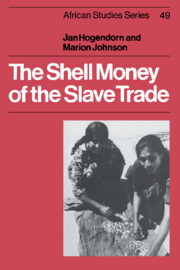Book contents
- Frontmatter
- Contents
- Maps
- Tables and chart
- Preface
- Introduction
- 1 The cowrie
- 2 The Maldive Islands
- 3 The Portuguese domination
- 4 The Dutch and English enter the trade (seventeenth century)
- 5 Prosperity for the cowrie commerce (eighteenth century)
- 6 Boom and slump for the cowrie trade (nineteenth century)
- 7 Collection, transport and distribution
- 8 Cowries in Africa
- 9 The cowrie as money: transport costs, values and inflation
- 10 The last of the cowrie
- Notes
- Bibliogaphy
- Index
3 - The Portuguese domination
Published online by Cambridge University Press: 12 October 2009
- Frontmatter
- Contents
- Maps
- Tables and chart
- Preface
- Introduction
- 1 The cowrie
- 2 The Maldive Islands
- 3 The Portuguese domination
- 4 The Dutch and English enter the trade (seventeenth century)
- 5 Prosperity for the cowrie commerce (eighteenth century)
- 6 Boom and slump for the cowrie trade (nineteenth century)
- 7 Collection, transport and distribution
- 8 Cowries in Africa
- 9 The cowrie as money: transport costs, values and inflation
- 10 The last of the cowrie
- Notes
- Bibliogaphy
- Index
Summary
In the first years after Vasco da Gama's arrival at Calicut, the Portuguese must often have seen cowries in use and on sale in Indian markets. They did not make contact with Maldive cowrie-carrying vessels until 1503, and that first contact the unfortunate Maldivians had good reason to rue. Gaspar Correa, in his Lendas da India, gives a vivid account of how Vicente Sodre, Chief Captain of the Fleet after da Gama's departure for home in 1502, captured four Maldive ships close off Calicut. That city had resisted the Portuguese cartaz, or pass system, and Sodre had forbidden the merchants of Calicut to trade with the islands. The Maldive merchantmen were carrying coir rope, dried fish, fabrics and cowries, which, says Correa, “are small white shells found among the islands in such quantity that ships make their cargoes of them. In these a great trade is carried on with Bengal, where they are current as money.” The ships had been chartered by a large number of “Moors of Calicut” who had purchased cargoes in the Maldives and were aboard, accompanying their goods back to Calicut. Vicente Sodre's treatment of this little convoy was quick and violent, presaging future Portuguese efforts to control the cowrie trade by conquest. He threatened to burn both ships and men unless the “Moors” of Calicut were pointed out. This having been done, the unarmed Maldivian captains and crews then had to watch the Moors bound, put in the hold of one ship from which the cargo had been removed, and then burned to death when the ship was fired.
- Type
- Chapter
- Information
- The Shell Money of the Slave Trade , pp. 28 - 36Publisher: Cambridge University PressPrint publication year: 1986

